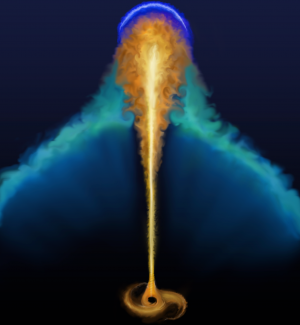Difference between revisions of "Electromagnetic counterpart of GW events"
| Line 3: | Line 3: | ||
In our group we work on solving open issues about GRB physics, with both a theoretical and an observational approach. The jet launching mechanism, the jet structure, particle acceleration, emission and dissipation processes are all open points in the GRB field, which need to be addressed. The exploitation of multi-wavelength data from different observatories (from radio to γ-rays) is necessary to fully characterise the spectral and temporal properties of these enigmatic objects. A complete and extensive exploration of the GRB phenomenology is of cardinal importance to establish the optimal observational strategy for current and next-generation astronomical facilities, in synergy with gravitational wave observatories. The optimisation of joint detection strategies relies on the knowledge of GRB population properties, which, for the sub-class of short GRBs, is still incomplete and needs to be refined.<br> | In our group we work on solving open issues about GRB physics, with both a theoretical and an observational approach. The jet launching mechanism, the jet structure, particle acceleration, emission and dissipation processes are all open points in the GRB field, which need to be addressed. The exploitation of multi-wavelength data from different observatories (from radio to γ-rays) is necessary to fully characterise the spectral and temporal properties of these enigmatic objects. A complete and extensive exploration of the GRB phenomenology is of cardinal importance to establish the optimal observational strategy for current and next-generation astronomical facilities, in synergy with gravitational wave observatories. The optimisation of joint detection strategies relies on the knowledge of GRB population properties, which, for the sub-class of short GRBs, is still incomplete and needs to be refined.<br> | ||
| + | |||
| + | From the EM observation of GRB170817, it was possible to constrain the jet structure of the GRB, namely its geometry and the angular energy distribution. Such structure likely deviates from the spherical approximation due to the interaction of the jet with the post-merger ejected material. A deeper comprehension of the structure formation and the nature of the emission processes would allow us to correctly predict the EM emission at all angles and in all energy bands.<br> | ||
| + | |||
| + | As part of our projects, we are developing theoretical tools to predict the EM emission from a structured jet, in order to evaluate the rate of joint detections that ET, in synergy with future astronomical facilities, will be able to achieve. Such studies can test the intriguing hypothesis of a universal jet structure, which impact on the overall properties of the short GRB population, e.g. the luminosity function. | ||
| + | |||
| + | Future joint GW+EM detections will also allow to shed light on the nature of the remnant, which in turn is responsible for the jet launching. Indeed, it is currently under debate whether a neutron star, as final product of a compact binary merger, is capable to create the favourable conditions for the jet collimation and ejection. The high sensitivity of future GW detectors, like the Einstein Telescope, will probe the nature of the post-merger object and pose a final answer to this issue.<br> | ||
Revision as of 20:18, 8 April 2021
With the joint detection of GW170817/GRB170817 we had for the first time the confirmation that short GRBs are associated to the coalescence of compact binaries. Such epochal discovery opened the door for a revolutionary era for astronomy.
In our group we work on solving open issues about GRB physics, with both a theoretical and an observational approach. The jet launching mechanism, the jet structure, particle acceleration, emission and dissipation processes are all open points in the GRB field, which need to be addressed. The exploitation of multi-wavelength data from different observatories (from radio to γ-rays) is necessary to fully characterise the spectral and temporal properties of these enigmatic objects. A complete and extensive exploration of the GRB phenomenology is of cardinal importance to establish the optimal observational strategy for current and next-generation astronomical facilities, in synergy with gravitational wave observatories. The optimisation of joint detection strategies relies on the knowledge of GRB population properties, which, for the sub-class of short GRBs, is still incomplete and needs to be refined.
From the EM observation of GRB170817, it was possible to constrain the jet structure of the GRB, namely its geometry and the angular energy distribution. Such structure likely deviates from the spherical approximation due to the interaction of the jet with the post-merger ejected material. A deeper comprehension of the structure formation and the nature of the emission processes would allow us to correctly predict the EM emission at all angles and in all energy bands.
As part of our projects, we are developing theoretical tools to predict the EM emission from a structured jet, in order to evaluate the rate of joint detections that ET, in synergy with future astronomical facilities, will be able to achieve. Such studies can test the intriguing hypothesis of a universal jet structure, which impact on the overall properties of the short GRB population, e.g. the luminosity function.
Future joint GW+EM detections will also allow to shed light on the nature of the remnant, which in turn is responsible for the jet launching. Indeed, it is currently under debate whether a neutron star, as final product of a compact binary merger, is capable to create the favourable conditions for the jet collimation and ejection. The high sensitivity of future GW detectors, like the Einstein Telescope, will probe the nature of the post-merger object and pose a final answer to this issue.
